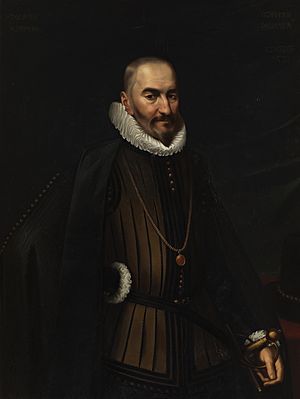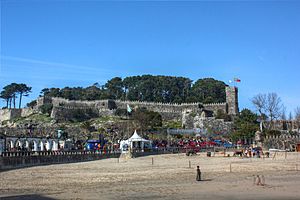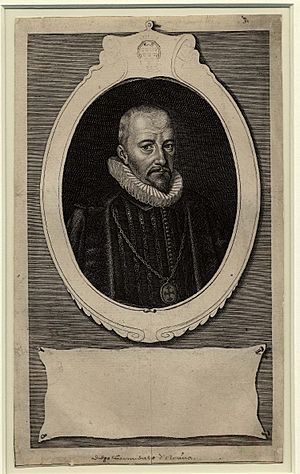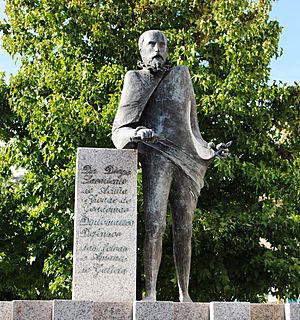Diego Sarmiento de Acuña, Count of Gondomar facts for kids

Diego Sarmiento de Acuña, Count of Gondomar (born November 1, 1567 – died October 2, 1626) was an important Spanish diplomat. He came from Galicia, a region in Spain. He is best known for being Spain's ambassador to England from 1613 to 1622. After that, he remained a top expert on English affairs for Spain until he died.
During his time, many people in England thought he was the leader of a Spanish group at the English royal court. They believed he knew King James I's secret thoughts. Some even saw him as a clever schemer for the Catholic Church.
Early Life of Gondomar

Diego Sarmiento de Acuña was born in Astorga, a town near Galicia. He was the oldest son of a Galician knight, also named Diego Sarmiento de Acuña. His father was in charge of areas like Toro and the Canary Islands. His mother, Juana de Acuña, came from a noble family. Diego inherited large lands in both Galicia and Old Castile.
When he was young, Diego helped defend Spain during the Anglo-Spanish War. In 1585, he helped fight off an English attack led by Sir Francis Drake on the towns of Baiona and Vigo. Four years later, he met Drake's forces again in Vigo. This was after the "English Armada" had been stopped in A Coruña and Lisbon.
Because of his success in these battles, King Philip II of Spain made him governor of Baiona. He also became the keeper of the fortress of Monte Real. This job meant he protected the southern border and coastline of Galicia. Later, in 1596, he became a corregidor (a type of local governor) first in Toro, then in Valladolid. Valladolid was the capital and home of King Philip III of Spain at the time.
Diego had to balance his roles as a courtier (someone who advises the king) and a soldier. In 1603, he was sent to Vigo to manage treasure brought from America by two ships. In 1609, he helped stop a Dutch navy attack on the coast of Galicia. Even though he had military and administrative jobs, he lived mostly in Valladolid. There, he started collecting a large and impressive library of books. He was known as a friend of the king's favorite advisor, the Duke of Lerma. In 1612, he was chosen to be the ambassador to England. He began this important job in May 1613.
Ambassador in London
Gondomar became famous as a diplomat because of his two times serving in England. He was there from 1613 to 1618, and again from 1619 to 1622. He was very good at speaking Latin, which pleased King James I, who loved books and learning. Gondomar understood the king very well. He praised the king's love for books and his desire for peace.
Gondomar also cleverly used the king's wish for his son, the Prince of Wales, to marry a Spanish princess, Maria Anna of Spain. This proposed marriage was known as the "Spanish Match". One British historian, J. P. Kenyon, called Gondomar "a cleverer man than any in England." He was skilled enough to keep England allied with Spain for about ten years.
Gondomar's main goal as ambassador was to stop King James from helping Protestant countries. This was important because the Thirty Years' War was about to begin. He also wanted to prevent English attacks on Spanish lands in the Americas. His success made him very unpopular with groups in England who disliked Spain and were very religious Protestants (Puritans).
Many people especially hated him for his part in the execution of Sir Walter Raleigh. Popular writers attacked him in pamphlets. One famous pamphlet, Vox populi, spread many false stories about him. The writer Thomas Middleton even made Gondomar a main character in his play A Game at Chess, which was later banned.

The Howard family were Gondomar's main friends at the English court. They included important figures like the Earl of Suffolk and the Earl of Arundel. The Howards wanted Prince Charles to marry a Spanish princess instead of a French one. They also preferred to avoid war with Spain, which many Puritans wanted. Most of the Howards were Catholic, which made them more open to religious tolerance in England. Many people at the English court, including some Howards, received money from Spain. However, this didn't always change their opinions or actions much. Gondomar often didn't have enough money to give out as much as he wanted. An embarrassing list from 1613 even showed that King James himself was receiving money from Spain.
Gondomar saw his job as an ambassador like a military mission in enemy territory. His motto was "risk your life and dare to die." One of his first challenges was refusing to lower the Spanish flag when his warships entered Portsmouth harbor. He appealed directly to the king, which prevented a fight. He also managed to get a Catholic activist, Luisa Carvajal y Mendoza, released from prison without conditions. This showed King James that Gondomar was a strong person. In 1617, Sarmiento was given the title of Count of Gondomar.
Gondomar's success came from his relationship with King James. He made the king admire and like him. James enjoyed Gondomar's clever and educated company, his honesty (within limits), and his personal integrity. They even called each other the "two Diegos" and drank from the same bottle. After a failed meeting of Parliament in 1614, King James famously told Gondomar, "I am amazed that my ancestors should have allowed such an institution to come into existence."
One of Gondomar's early goals was to stop the marriage talks between Prince Charles and the sister of Louis XIII of France. This French marriage would have balanced out Spain's alliances.
Gondomar also played a key role in the case of Sir Walter Raleigh. It was Gondomar's strong pressure that led to Raleigh being executed on October 29, 1618. King James had shown Gondomar the agreement for Raleigh's voyage. This agreement said Raleigh could not attack Spanish settlements. James did this to calm Gondomar's worries about Raleigh's trip. But Raleigh attacked San Thomé (near modern Ciudad Guayana), which was a clear violation. Raleigh's execution helped keep the peace with Spain. The English people could not forgive Gondomar for this. In 1618, Gondomar was allowed to go home for his health. But he was then ordered to travel through Flanders and France for another diplomatic mission.
In 1619, he returned to London and stayed until 1622. In 1620, Roger North led an expedition to Guyana. This seemed like another attack on Spanish settlements, similar to Raleigh's. At Gondomar's request, North was put in prison.
One of the last big disagreements was about Count Mansfeld moving troops from England. These troops were meant to help King James's son-in-law, Frederick V, Elector Palatine, who was called the "Winter King" of Bohemia. Spain and Austria were worried that France might join Mansfeld's forces. So, the plan was eventually dropped.
When Gondomar was finally allowed to retire and return to Spain, he became a member of the royal council. He was also made governor of one of the king's palaces. He went on a special mission to Vienna. Gondomar was in Madrid when the Prince of Wales (who later became King Charles I) visited Spain looking for a wife. Gondomar died at a house near Haro in La Rioja.
Gondomar was married twice. First to his niece, Beatrix Sarmiento, but they had no children. Then to his cousin, Constanza de Acuña, with whom he had four sons and three daughters. The strong dislike he faced in England, including jokes about a stomach problem he had for years, showed how dedicated he was to serving his own king.
Gondomar collected a wonderful library of books and old writings. He started this collection before he came to London and continued it while he was there. His letters often mention how he wanted his books arranged, bound, and stored in his house in Valladolid. In 1785, his family gave the library to King Charles III of Spain. Today, it is kept in the Royal Library in Madrid.
A painting of Gondomar, thought to be by the famous artist Diego Velázquez, used to be in Stowe, Buckinghamshire.
Gondomar and the Galician Language
Some of Gondomar's private letters to his family and other Galician noblemen have been saved. These letters are often written partly or completely in the Galician language. They are very important because they help us understand how the language changed from Old Galician to Middle Galician. There are not many other writings from that time period.
Gondomar is also known for his writings that proudly defended Galicia. He wrote about the long history and importance of the Kingdom of Galicia and its people. He believed that 'Galicia was a Kingdom and her kings got this title well before any other in Spain.'
See also
 In Spanish: Diego Sarmiento de Acuña para niños
In Spanish: Diego Sarmiento de Acuña para niños


